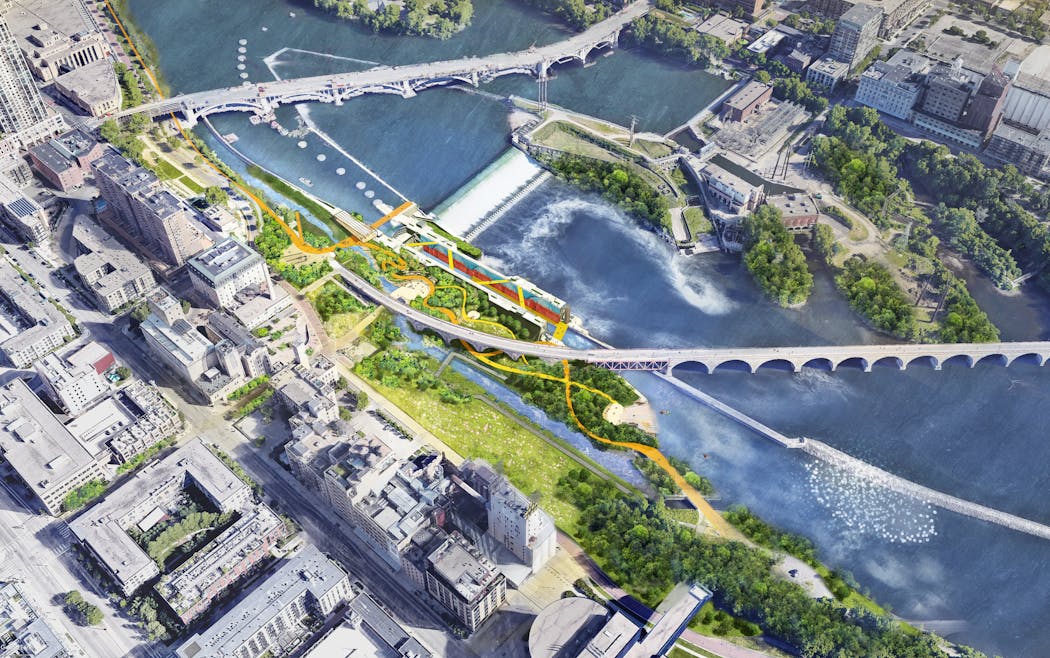A historic stretch of Minneapolis' downtown riverfront could soon return to tribal hands.
Friends of the Falls unveiled a new leader and renderings for Mississippi River land adjacent to St. Anthony Falls on Friday. Shelley Buck, former president of the Prairie Island Indian Community, replaces retiring Friends of the Falls president Mark Andrew. Her appointment coincides with a Native-majority board of directors.
Working with the city of Minneapolis and Minneapolis Park Board, the Friends will consult Dakota nations on potentially reassuming ownership of what was traditionally a Dakota sacred site.
Prior to the European settlement of Minneapolis and the milling industry's destruction of the natural St. Anthony Falls in 1869, the waterfall and the limestone islands at its base were where the Dakota people held ceremonies and gave birth. One of those islands, Spirit Island, was quarried to build the city.
"We don't normally get people wanting to help tribes get their land back, especially land that's so important to us," Buck said of recent efforts to facilitate the land-back initiative. "Usually, the lands have been — like Spirit Island — desecrated ... looted, with our people's remains on display. So for someone to to be working to get federal land back that did such devastation to our original homelands, a site that's so important, it's a huge deal."
The 3 acres in question is located at the west bank of the Stone Arch Bridge. They include a fenced parking lot — a parcel of the federally-owned Upper St. Anthony Falls Lock and Dam. When Congress closed the lock in 2015 to prevent the spread of invasive carp, the U.S. Army Corps of Engineers looked to transfer the lock and surrounding lands to local ownership.
Minneapolis' role
While no local entity has expressed an interest in owning a deactivated lock — the infrastructure once used to lift and lower boats on the river — the federal government is expected to convey the adjacent lands to the city this year.
Minneapolis Mayor Jacob Frey said he is open to the city holding the property only temporarily, pending consultation with tribal councils on the role they want to play in redevelopment and long-term ownership of the site.
"This project is bringing Native and non-Native communities together to create a shared vision for the Falls," Frey said in a statement.
The tribes must weigh liability, costs and construction logistics, Buck said. But taking control would present an opportunity to create a place of healing and public education.
A new landscape
The concepts released Friday are a far cry from Friends of the Falls' first idea — circa 2016 — to build a visitor center telling the story of Minneapolis' birth as a milling city that harnessed the hydrological power of the only waterfall on the Mississippi River.
"The real story [of the St. Anthony Falls Historic District] hadn't been told," Andrew said. "Not only had it not been told, it was actually being whitewashed because there was no mention of Native American culture. And so we got into animated discussions around what's fair, what's ethical, what's appropriate and decided that it shouldn't be a visitor center for the city but rather an opportunity to tell a truth-telling history of what has happened at that site. So that's when we shifted gears."
Preliminary concept renderings show winding pathways with interpretive signage, gathering places for ceremony and healing and a river access point. A dramatic channel of water flows through an area currently occupied by surface parking lots — a nod to a year-long series of community conversations that emphasized the Indigenous value "water is life."
The designs were published on the Friends of the Falls website Friday.
Buck will continue to represent the Friends' interests in ongoing negotiations with the U.S. Army Corps of Engineers over the future of the lock and dam. The Friends advocate for continued federal control of its infrastructure, which will require costly maintenance.

Want to share info with the Star Tribune? How to do it securely

'Safe recovery sites' would offer syringes, naloxone and more to people using drugs. The plan could be in peril.
New Minnesota GOP leaders seek peace with party's anti-establishment wing

Who is Republican Lisa Demuth, Minnesota's first House speaker of color?



